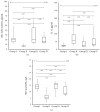Modulatory effect of resveratrol and melatonin on natural killer cell activity and adrenomedullin in diabetic rats
- PMID: 34174798
- PMCID: PMC10734853
- DOI: 10.3906/sag-2104-380
Modulatory effect of resveratrol and melatonin on natural killer cell activity and adrenomedullin in diabetic rats
Abstract
Background: Epidemiological evidence suggests that diabetes poses a high risk for many chronic diseases, especially cardiovascular diseases, and cancer by stimulating many inflammatory and immunological pathogenic mediators and affecting natural killer (NK)-cell activity. In this study, the effects of melatonin and resveratrol on IL-6, TNF-alpha, oxidant/antioxidant capacity, NK-cell activity, and mid-regional proadrenomedullin (MR-proADM) levels of diabetic rats were investigated.
Methods: In the study, 28 Sprague Dawley rats were randomly divided into the control group (group I) and 3 streptozotocininduced diabetes mellitus (DM) groups (group II, III, and IV), each group consisting of 7 rats. Five mg/kg/day melatonin to group III and 5 mg/kg/day resveratrol (intraperitoneal) to group IV was given. At the end of 3 weeks, NK-cell activity, total antioxidant/oxidant capacity, MR-proADM, IL-6, and TNF-alpha levels were measured in intracardiac blood taken under anesthesia.
Results: NK-cell activity of group II was found lower than group I, group III, and group IV (7.4 ± 2.0 vs. 22.5 ± 11.9, 30.6 ± 22.5 and 20.4 ± 9.1 pg/mL; p = 0.0018, respectively). The difference was more prominent in diabetic rats receiving melatonin (p < 0.01). TNF-alpha levels of group II were higher than the group I (p < 0.05). The MR-proADM levels of group II were found to be lower than the group I and group III (6.4 ± 3.6 vs. 14.4 ± 3.2 and 14.0 ± 4.2 ng/L; p < 0.05, respectively). In addition, NK-cell activity was moderately correlated with MR-proADM (r = 0.5618, p = 0.0019).
Keywords: Diabetes mellitus; melatonin; mid-regional proadrenomedullin; natural killer cell activity; resveratrol.
Conflict of interest statement
The authors declare that they have no conflicts of interest. No financial support was received from any institution or company for this study. No financial support was received from any institution or company except our own institution (The University of Health Sciences, Turkey) for this study. We do not have financial and business conflicts of interest with our employer or other organizations.
Figures



Similar articles
-
Resveratrol Has Histone 4 and Beta-Defensin 1-Mediated Favorable Biotherapeutic Effects on Liver and Other Target Organs in Diabetic Rats.Turk J Gastroenterol. 2024 Mar;35(3):223-231. doi: 10.5152/tjg.2024.23068. Turk J Gastroenterol. 2024. PMID: 39128051 Free PMC article.
-
The effects of resveratrol and melatonin on biochemical and molecular parameters in diabetic old female rat hearts.Exp Gerontol. 2023 Feb;172:112043. doi: 10.1016/j.exger.2022.112043. Epub 2022 Dec 6. Exp Gerontol. 2023. PMID: 36494013
-
Cardioprotective potential of melatonin, quercetin and resveratrol in an experimental model of diabetes.Biotech Histochem. 2022 Feb;97(2):152-157. doi: 10.1080/10520295.2021.1918766. Epub 2021 Apr 28. Biotech Histochem. 2022. PMID: 33906539
-
Amelioration of streptozotocin-induced diabetic nephropathy by melatonin, quercetin, and resveratrol in rats.Hum Exp Toxicol. 2015 Jan;34(1):100-13. doi: 10.1177/0960327114531995. Epub 2014 May 8. Hum Exp Toxicol. 2015. PMID: 24812155
-
Melatonin, quercetin and resveratrol attenuates oxidative hepatocellular injury in streptozotocin-induced diabetic rats.Hum Exp Toxicol. 2015 Sep;34(9):859-68. doi: 10.1177/0960327114559993. Hum Exp Toxicol. 2015. PMID: 26286521
Cited by
-
Melatonin, BAG-1 and cortisol circadian interactions in tumor pathogenesis and patterned immune responses.Explor Target Antitumor Ther. 2023;4(5):962-993. doi: 10.37349/etat.2023.00176. Epub 2023 Oct 25. Explor Target Antitumor Ther. 2023. PMID: 37970210 Free PMC article. Review.
-
Oxidative Stress in Mucopolysaccharidoses: Pharmacological Implications.Molecules. 2021 Sep 16;26(18):5616. doi: 10.3390/molecules26185616. Molecules. 2021. PMID: 34577086 Free PMC article. Review.
-
Psycho-Neuro-Endocrine-Immunology: A Role for Melatonin in This New Paradigm.Molecules. 2022 Jul 30;27(15):4888. doi: 10.3390/molecules27154888. Molecules. 2022. PMID: 35956837 Free PMC article. Review.
References
MeSH terms
Substances
LinkOut - more resources
Full Text Sources
Research Materials
Miscellaneous

